For those who haven’t been happy memorizing the definitions of gerund or participle, there are many other resources for approaching the weird and wonderful world of words and language. See below for everything from a murderous panda to the world’s worst alphabet book, bug language, an unpronounceable poem, bad (even Deplorable) words, a delightfully difficult dictionary, and the best book ever on opposites.
Table of Contents
GRAMMAR: GENERAL
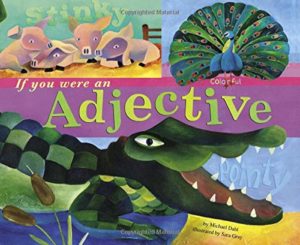 |
The Word Fun series (Picture Window Books) includes such titles as If You Were an Adjective, If You Were a Noun, If You Were a Verb, and If You Were a Pronoun. All are brightly illustrated picture books with word examples in colorful fonts. For ages 6-9. |
 |
Ruth Heller’s gorgeously illustrated “World of Language” picture-book series introduces kids to parts of speech through a clever (and memorable) rhyming text and gloriously colored pictures. Titles in the series (Puffin, 1998) include Merry-Go-Round: A Book About Nouns; Kites Sail High: A Book About Verbs; Many Luscious Lollipops: A Book About Adjectives; Up, Up and Away: A Book About Adverbs; Behind the Mask: A Book About Prepositions; Mine, All Mine: A Book About Pronouns (1999); and Fantastic! Wow! and Unreal!: A Book About Interjections and Conjunctions (2000). For ages 5-9. |
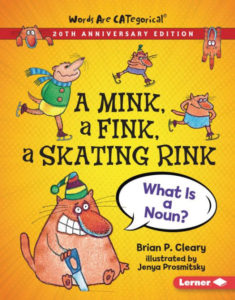 |
Brian P. Cleary’s “Words Are Categorical” series is a collection of light-hearted cartoon-illustrated picture books, each detailing a different part of speech. Many titles (Millbrook Press) including A Mink, A Fink, A Skating Rink: What Is a Noun?; To Root, To Toot, To Parachute: What Is a Verb?; I and You and Don’t Forget Who: What Is a Pronoun?; Hairy, Scary, Ordinary: What Is an Adjective?; Dearly, Nearly, Insincerely: What Is an Adverb?; and Under, Over, By the Clover: What Is a Preposition? Try this, for example, from Hairy, Scary: Adjectives, Cleary explains, “modify nouns in ways that help tell us/If someone’s sincere, delighted, or jealous/If jackets are herringbone, pin-striped, or plaid/If babies are crabby, excited, or glad.” For ages 7-11. |
 |
Karen Elizabeth Gordon’s The Deluxe Transitive Vampire (Pantheon, 1993). Subtitled “The Ultimate Handbook of Grammar for the Innocent, the Eager, and the Doomed,” covers basic grammar with black-and-white Victorian woodcuts, a cast of characters that includes vampires, trolls, and gargoyles, and a lot of peculiar behavior. (“The werewolf or his wife wreaked havoc in the pantry.”) For ages 13 and up. In a similar vein, also see Gordon’s The New Well-Tempered Sentence (Mariner Books, 2003), which deals with all the ins and outs of punctuation. (“Other fortresses under his jurisdiction have never sought clemency for March hares.”) |
 |
By William Strunk, Jr., and E.B. White, The Elements of Style (Pearson, 1999) is a classic for students of grammar. Just over 100 pages long, it’s a concise collection of rules of usage along with a helpful list of commonly misused words in alphabetical order. For ages 13 and up. |
 |
By Benjamin Dreyer – longtime copy chief at Random House – Dreyer’s English (Random House, 2019) is both a grammar book and an absolutely delightful read, filled with examples, information, and a lot of superb (and opinionated) advice for writers. (Never use the word “actually” – “because, seriously,” writes Dreyer, “it serves no purpose I can think of except to irritate.”) Highly recommended for teens and adults. |
 |
Patricia O’Connor’s Woe Is I (Riverhead Books, 2019) points out that English is an ever-changing language. Witness, for example, the current use of a singular “they,” “them,” and “their” as a gender-neutral pronoun – and, says Connor, there’s nothing wrong with “taller than me” as a simple comparison. Chapters include “Woe Is I: Therapy for Pronoun Anxiety” (“When a tiny word gives you a big headache, it’s probably a pronoun”), “Comma Sutra: The Joy of Punctuation,” and “The Living Dead: Let Bygone Rules Be Gone.” For teens and adults. |
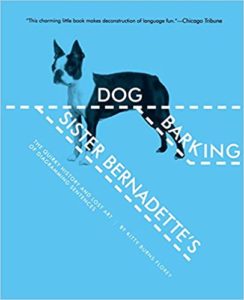 |
Kitty Burns Florey’s Sister Bernadette’s Barking Dog (Mariner Books, 2007) is subtitled “The Quirky History and Lost Art of Diagramming Sentences” – yes, a whole book on diagramming sentences, which Florey explains she learned in sixth grade from Sister Bernadette. It’s a hoot to read (“Trying to stuff the complexities of the English language into flat visual structures is a bit like trying to force a cat into the carrier for a trip to the vet”) and makes diagramming sentences look like a new form of parlor game. Florey calls it a cross between math and art. For ages 12 and up. |
 |
Check out Grammar Girl for catchy and interesting podcast episodes and articles on the rules and quirks of grammar. Sample titles: “Stationery versus Stationary,” “The History and Glory of the Spelling Bee,” “Bring versus Take,” and “Up with Which I Will Not Put!” |
PUNCTUATION
 |
In Robin Pulver’s Punctuation Takes a Vacation (Holiday House, 2004), the punctuation marks all head for Take-A-Break Lake (on the hottest day of the year), leaving Mr. Wright’s class in chaos. Postcards from the missing marks emphasize just how important they are. For ages 5-8. Also by Pulver, see Nouns and Verbs Have a Field Day (Holiday House, 2007) and Silent Letters Loud and Clear (Holiday House, 2010). |
 |
By Elsa Knight Bruno, Punctuation Celebration (Square Fish, 2012) is an illustrated collection of fourteen poems about punctuation marks. (“The period is just a dot/Found sitting in its/favorite spot./When a sentence ends,/it comes and plops,/And where it plops/the sentence STOPS.”) For ages 5-9. |
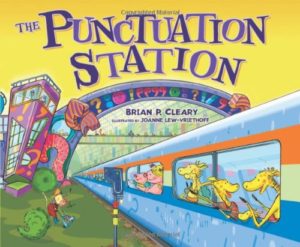 |
In Brian P. Cleary’s The Punctation Station (Millbrook Press, 2028), a family of giraffes are on a train heading from Period Plaza to Punctuation Station, learning the proper uses of period, comma, apostrophe, question mark, hyphen, exclamation point, and quotation marks en route. All in catchy rhyme. For ages 5-9. |
 |
The title character of Amy Krouse Rosenthal’s Exclamation Mark (Scholastic, 2013) struggles to fit in – which seems hopeless. He even considers giving up and running away – until he meets an aggressive question mark and comes into his own. A delight for ages 4-8. |
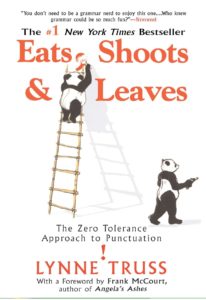 |
Lynn Truss’s Eats, Shoots & Leaves (Avery, 2006), subtitled “The Zero Tolerance Approach to Punctuation,” is a catchy account of the uses and misuses of punctuation marks – with many examples of hideously punctuated signs (easily the basis for a game of “Spot the Awful Grammar” during trips by car). Just to emphasize the dangers of a misplaced comma, the cover has a picture of a potentially murderous panda. For teens and adults. |
 |
For younger readers, see Truss’s series of illustrated picture books, all demonstrating the potentially awful results of misused punctation. Titles include Eats, Shoots & Leaves (G.P. Putnam’s Sons, 2006), More Eats, Shoots & Leaves (2019), The Girl’s Like Spaghetti (2007), and Twenty-Odd Ducks (2008). For ages 6 and up. |
 |
Seriously – an entire book on the semicolon? Cecelia Watson’s Semicolon: The Past, Present, and Future of a Misunderstood Mark (Ecco, 2019) is a chatty history of the much-debated semicolon. (My favorite punctuation mark.) For teens and adults. |
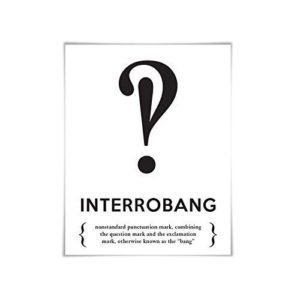 |
Interrobang? Check out these 6 Punctuation Marks That Don’t Exist But Totally Should. |
 |
From the New York Times, see What’s Your Favorite Punctuation Mark? |
